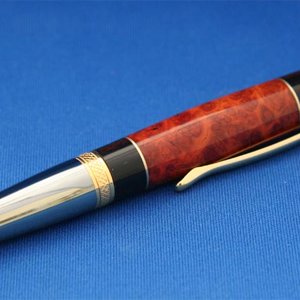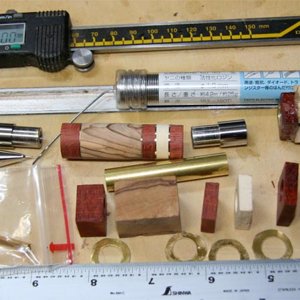Hippie3180
Member
Is there a secret to turning metal rings? I have some metal discs, and I'm trying to turn copper placed between my cap and finial, it's getting so darn hot. Any tips and tricks to this.
So these are cut with a disc cutter, we don't have one, but you can find these on Etsy in all kinds of sizes and metals. They are a bit testy to deal with, obviously you have to drill a hole through them. We use a wood lathe and not a metal lathe so they are also a bit challenging to turn and hard on tools. We use carbide and things get super hot.Hippie3180, do you have any photos of this endeavor? I'm curious to depart from the factory rings, collars, etc.
I guess ideally a metal lathe would be a better option. I'm not sure how to turn them down first really. I may just go with pick guard material to finesse up my pens instead.Very sharp tools, light cuts are what works for me. Try turning it down to as close to the final diameter as possible before putting it on the pen.
The one pictured that we were experimenting with is copper, it got super hot. I'll try a different approach to see if it helps.I'd suggest approaching this in passes from the side, opposed to just pushing the tool into the metal perpendicular to the work. Once the tool engages the metal enough to form chips, keep it moving. Rubbing is your enemy as it causes heat to build up.
Take breaks between passes, using air or water (not the safest, but I'd probably dab a wet rag to the spinning part if there weren't any major catches to grab the cloth) to help cool things down.
Finally, maybe look at a different source of metal. Copper usually isn't too difficult to cut (compared to other metals). I'm guessing those disks are stamped and as a result, likely work hardened. This makes it a bit more difficult for you.
Good luck
Hmm, cans? Thanks for some ideas to try.Don Kirk's book on modifying Slimline pens has information using metal from soda cans, credit cards, plastic bottle caps and plastic signs. Hippie, thanks for the reply.



Ah ha! Yes, this might be the solution we've been looking for. We'll give this a whirl. Thank you!Are you talking about rings such as brass or aluminum/silver rings that are used as separators in some segmented pens?
Pens such as this:

Imported Photo from leehljp
Imported Photo from leehljp. Please edit title and description.www.penturners.org
Rings such as in the bottom of this photo:

I place brass sheets between 1/2" plywood plates.I screw it down all the way around. Mark out my spaces and drill with the size hole I want. Take the screws out and then cut rough round circles. That makes them deformed cutting them out, but I use a flattening hammer on an anvil to re-flaten them. Then when in a pen segment, I turn then round with a carbide insert.
Grizzly used to have a Hand Punch set that made different size rings. a smaller version of this:

Grizzly T21321 - Hand Punch - Grizzly Industrial, Inc.
<h1>Grizzly T21321 Hand Puncher</h1> <h2>Punch holes in steel up to 3/16" thick.</h2> <p>This hand puncher is ideal for hobbyists or metalwork enthusiasts who work on projects with sheet metal up to 3/16" thick.</p> <p>It's a relatively inexpensive and easy-to-use tool compared to electric or...www.grizzly.com
and similar to this one on amazon but made for punching thin metal and capable of punching rings out of thin metal sheets.
Copper is a nightmare to turn, very "grabby", I avoid it at all cost. Try brass, the 360 alloy machines beautifully, stay away from the red brasses, they have a lot of copper in them.The one pictured that we were experimenting with is copper, it got super hot. I'll try a different approach to see if it helps.
Have you tried drilling leftover blank pieces & parting off pickguard thickness washers to use as appropriate accents?I guess ideally a metal lathe would be a better option. I'm not sure how to turn them down first really. I may just go with pick guard material to finesse up my pens instead.
Perhaps you're right, I also think the gauge is too substantial, we could've gone thinner.One of the problems you may be having is the use of carbide tools. I tried using my carbide and found they did not work well with metals. Using HSS traditional tools, I haven't had any problems. I have even used roofing steel and have not had any issues, but I only did that one time because the metal was so hard.
Well now, this is something I did not know. Good to know, thank you.Copper is a nightmare to turn, very "grabby", I avoid it at all cost. Try brass, the 360 alloy machines beautifully, stay away from the red brasses, they have a lot of copper in them.
Lew, you are right. I did use my HSS tools instead of the carbide inserts. Age is getting to my mind!One of the problems you may be having is the use of carbide tools. I tried using my carbide and found they did not work well with metals. Using HSS traditional tools, I haven't had any problems. I have even used roofing steel and have not had any issues, but I only did that one time because the metal was so hard.
I've seen this done, I have a wood lathe, I'm not sure how precise or small I could get them, but certainly an option.Have you tried drilling leftover blank pieces & parting off pickguard thickness washers to use as appropriate accents?
Makes perfect sense, I was just thinking if you wanted two on your cap for example, could you get them close to the same width, with out a metal lathe, and really I'm sure you could.I leave them the OD of the blank, glue to the finial tenon before turning the finial to size & then turn it as a single piece, clean up the tenon, then thread.
